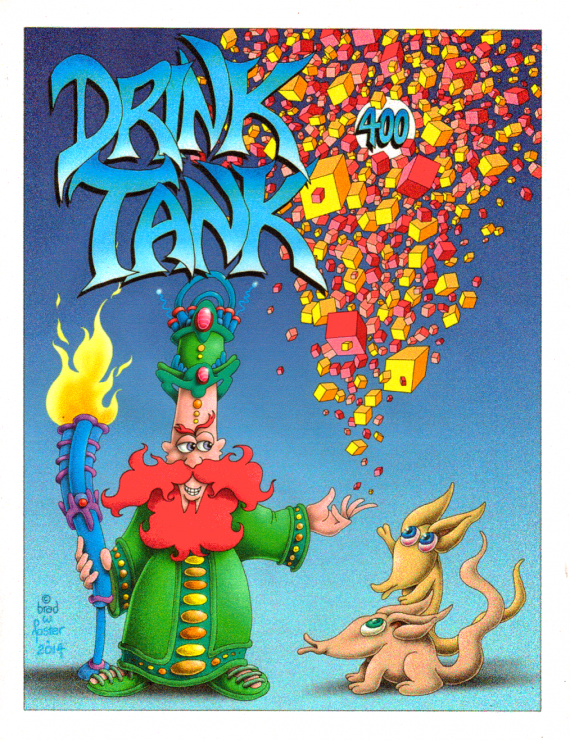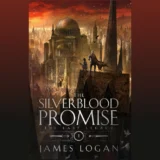
Fanzines reviewed: BREAKING IT ALL DOWN (#5), CHALLENGER (#38), THE DRINK TANK (#400), THE PLEASURE OF RUINS (#2), and CONFUSION (#16).
(Please note: Zine reviews are prepared a week or more in advance of publication of this column and may not necessarily include the latest issue available, but the link to multiple issues given at the bottom of each review probably does.)

BREAKING IT ALL DOWN (#5) – Winter 2015 – Find it here
Faned: Alexander Case. American Mediazine.
The emphasis of this zine seems to be on Anime and Cosplay. Subjects about which I know very little, so I was very curious to see how Alex handles them.
First off, a letter column, which includes a LoC from Lloyd Penney. Always a good sign of a healthy zine.
Then follows a brief review of the Kumoricon Anime con in Vancouver (Washington) which includes a series of photos Alex took of cosplayers at the con, each with a paragraph or two of explanation. I was surprised to recognize a few characters before I read the accompanying text, characters like Hellsing, and Detective L. from “Deathnote.” (I refuse to admit I recognized a “Sailor Moon” character.) Maybe I’m not as ignorant as I thought.
In his report on Orycon I note with interest Alex attended “a fanzine panel called ‘Print is Undead.’ The panel itself was fairly under populated, with the only people present being the panelists and myself.” Alas, this is quite common at conventions these days. He noticed that the majority of the zines discussed were “focused more on community journalism over fandom, with mine being something of an exception.” I’m hoping “The Clubhouse” will help reverse this trend, or at least inspire more fans to start publishing zines!
Next come reviews of anime series with names like “Log Horizon” and “Kill La Kill” (never heard of them, but then I’ve never heard of 99.9% of anime films and TV shows). What surprises me is how widely different each is from the other. Eye-opening. I had no idea Anime was so sophisticated in its variety.
Breaking It All Down worth reading? – It is if you love Anime. But even if you are merely curious. Alex has a very clear and precise manner of analyzing and critiquing. His tone is very respectful of the genre, serious but not too serious. Good, objective criticism I’d say. This zine probably one of the best sources of intelligent appraisal of Anime in all its complexity.
( Multiple issues of Breaking It All Down here )

CHALLENGER (#38) – Summer/Fall 2014 – Find it here
Faneds: Guy H. & Rose Lillian. American Genzine.
Every issue has a theme. I had intended to wait till the very-soon-to-be-published next issue, but I like this one so much, because of its “What Future?” theme, that I choose to review it.
Gregory Benford contributes “a musing” on what the twenty-first century turned out to be. As he puts it “Our time is not the end of history, just the end of old illusions about our journey through history.” He has nothing good to say about university academics, or modern youth, or modern anything really. A strong sense of failure pervades his musing. Neither the left nor the right offer hope. In his view “solutions to cultural and political difficulties can be found in the deliberate cultivation of the empirical, individualistic, sceptical Western tradition.” In the broad sense I agree with him, despite my being – as I found out over a VCON 37 committee dinner with him in 2012 – too left wing for his taste, even though I consider myself, in Canadian terms, a conservative Liberal. But yes, I agree individualism is the key. Ghu knows I don’t want any government to hunt me down just because I’m me! Will the world get better? Stay tuned.
Joseph L. green examines the scientific predictions of both Jules Verne and H.G. Wells. Hit and miss as you might expect. Joseph makes the interesting point that Verne in particular suffered from an all too common failing in genre writers, namely linear extrapolation wherein the wonders of the future tend to be merely bigger and better versions of what already exists. Wells, at least, wigged out in all directions with impossible but fun concepts that allowed him to explore their potential effect on society. I enjoy Verne, but much prefer Wells.
A lengthy LoC column features Lloyd Penney among others. What I particularly like are the numerous stills from “Robot Monster” scattered among them.
Speaking of fun films, Jim Ivers contributes “A Brief (cinematic) History of the Future,” from “Metropolis” (1927) to “Blade Runner” (1982). What pleases me is that most of the films he describes are quite rare and seldom seen (at least on TV). And I’m especially thrilled to see him find virtues in “Creation of the Humanoids” (1960), a normally much underrated movie (which happens to have been Andy Warhol’s favourite film by the way).
Mike Resnick presents a humorous account of what must have been the living hell of the Baycon Worldcon in 1968. Apparently one of those cons riddled with unexpected disasters but much beloved in hindsight since it spawned so many good stories worth telling. In contrast the recent worldcon in London, as described by Gregory Benford, seems to have gone off pretty smoothly, but with some interesting peculiarities.
The complete Guest of Honour speech Mike Resnick gave at the Chicon 7 Worldcon is also included. Basically his life story told in a most entertaining fashion.
But I have to confess what I loved above all was the reprint of the short story “Zeppelin Terror” by W. Jas. Wentz which first appeared in “Spicy Zeppelin Stories” magazine in October 1928. However, I have my suspicions. First of all, the only “Zeppelin” pulp was titled “Zeppelin Stories.” Culture Publications put out “Spicy Western,” Spicy Mystery,” and similar, but no “Spicy Zeppelin Stories.” Secondly, this reprint was provided by Taral Wayne. AHA! I’m 99.9% convinced HE wrote it! If so, it’s brilliant. Captures the period atmosphere (as found in the pulps) perfectly.
Challenger worth reading? – This is a fantastic zine, rich and meaty, a veritable feast of fannish/genre lore and tradition. No wonder it attracts professionals of the likes of Benford and Resnick. First class all the way. I enjoyed every page.
( Multiple issues of Challenger here )

THE DRINK TANK (#400) – January/February 2015 – Find it here
Faned: Chris Garcia. American Genzine.
Since this is the very last issue (allegedly, though with Chris’ amazing energy level who can say), it not unexpectedly features brief articles by numerous previous contributors. Here are a couple of quotes from the tributes:
Milt Stevens – “Drink Tank hasn’t revolutionized American sexual behavior. As far as I know. However Drink Tank has had an impact on the fanzine field. The traditional fanzine was published on twiltone. That was the cheapest paper available. Drink Tank has been published on electrons. That’s even cheaper. It allowed Chris Garcia to produce rapid fire issues that came at you like a school of piranhas on their lunch break.”
Juan Sanmiguel – “Who is Chris Garcia? He is a beautifully crazy guy who created this publication so we could take a wild trip through fandom with him. Thanks for the ride.”
Chris Garcia himself once wrote – “Someday, I want folks to remember the Drink Tank not as part of some great movement, but as a fascinating dead-end.”
According to John Purcell, who did the appropriate number crunching, Chris, over a ten year period, published a new zine (“Drink Tank” but one of several), on average, every six days! This is not only a record, but manifestly some form of lunacy not previously observed. How did he accomplish this? By using the “The Garcia Method” which, claims Ric Bretschneider, consists of writing “in one sitting without revisions.” (Son of a gun! Awfully similar to the way I write these reviews!)
Sadly, no comment from Lloyd Penney.
The Drink Tank worth reading? – “The 52 Weeks to Science Fiction Film Literacy” series of film retrospectives alone qualifies “The Drink Tank” as a fannish delight. Chris Garcia be one of the rare Holy Madmen sent by Ghu to inspire us all. He is what the Japanese call “A living treasure.” A genuine phenomenon. Unique in his intensity and enthusiasm. He and all those he dragooned into contributing have made “The Drink Tank” run of 400 issues perpetually worth browsing through. A kind of mini-encyclopedia of fannish obsessions. You won’t be disappointed. Something for everyone.
( Multiple issues of The Drink Tank here )

THE PLEASURE OF RUINS (#2) – January 2015 – Find it here
Faned: R. Graeme Cameron. Canadian Perzine.
Great galloping Ghu! Is there no limit to Cameron’s ego? Reviews his own zine? What kind of megalomaniac fool… Don’t worry about it. Always wanted to be Emperor of Canada when I was young. After all, Nero was emperor by age 18. Elagabalus by 14. And here I am at 63 with no sign of a groundswell of popular support as yet… so I’ve calmed down quite a bit…
Fact is, The Pleasure of Ruins is rather an oddity, and not merely because I happen to be the publisher. It is a genuine example of something or other which could well be adapted as a role model for a type of SF&F zine.
When I first floated the idea back in November 2014, John Purcell responded “It wouldn’t be very interesting to me unless it is mainly about the people who are interested in archaeology –or the kind of more casual article that could never be published in the formal journals.”
How casual or formal is TPOR? The titles of the three main articles should give you a hint: “Are Icky Gods Better?” “That Old Fuddy Duddy Cicero,” and “Yet More Roman Sex,” the latter by Taral Wayne. Now you know why Guy Lillian reviewed TPOR as “goofy.”
You see, I’ve been interested in archaeology and ancient history as long as I’ve been interested in SF&F, which is to say, since I was a little kid. I can read a gigantic, formulaic tome and come away with but one fact stuck in my brain, that Nero played the Sicilian bagpipes. I find such facts very interesting. Delightful even. Roman historians wrote their works to instill moral lessons. I read them for a bit of a giggle. For a bit of fun. And I want to share the fun.
So much so that I don’t bother to name my sources or include footnotes. TPOR is not to be mistaken for a university paper or an article in a journal devoted to a single type of Etruscan pot. No sir. TPOR be a humour zine. I present isolated odd facts and riff on them in whatever manner I please, albeit with comic intent. Works for me. Might for you.
Lloyd Penney sent a letter commenting on the first issue but it got lost somewhere in my computer and so does not appear in this issue. That be my fault. We faneds not infallible! (Or, at least, I’m not.)
Will there ever be a science fiction connection? Oh sure, from time to time I hope to comment on assorted alien ruins and dead civilizations as depicted in genre literature. I just haven’t done the research as yet.
The Pleasure of Ruins worth reading? – If you have always suspected the ancients were as much a bunch of weirdos and crank obsessives as we are, yet some of them as gifted and innovative as modern society occasionally manages to be, then you’ll get a kick out of TPOR.
( First issue of The Pleasure of Ruins here )
AND FROM THE VAULTS:

CONFUSION (#16) – February 1953? – Find it here
Faned: Shelby Vick. American Genzine.
There’s no date in the zine, other than the February calendar on the cover, but from internal evidence I assume 1953 is the year it was published. The evidence consists of an article titled “Walt Willis discovers America.” It is actually the second half of chapter 26 of Walt’s “The Harp Stateside,” a report of his trip from Ireland to America to attend the 1952 Chicon II Worldcon in Chicago (Walt being the recipient of the very first Trans-Atlantic Fan Fund that year). He went on to explore Western fandom before returning home. Segments of his trip report were published in various fanzines. In this example, describing his visit to the Los Angeles Science Fantasy Society’s Club room (before they acquired their first Club house), Walt finds himself in a conversation with someone who mistakes him for a local first-timer.
“Of course,” he warned me, “This isn’t an ordinary club night. There’s some foreign fan or other coming to talk to us. It’ll probably be pretty dull.”
“I expect so,” I said.
“Guy named Willis, I think,” he went on. “You’d hardly have heard of him.”
“The name’s familiar,” I said loyally.
“If you like I’ll introduce you afterwards,” he said kindly.
“Gee thanks,” I said.
Walt was famous for his keen eyes and ears in noting the absurd in every situation and writing it up in a wry and witty manner. He was tremendously, unbelievably popular in his day, and still very well thought of in his later years. He passed away in 1998. To this day he is considered one of the greatest faneds of all time.
Another item, very curious, may possibly be of great significance. It’s the script of a play titled “The Play’s The Thing!” written by Bill Morse and Terry Wright, which takes place on a small asteroid “ten years after the war that blew up the world.” John and Ella survived, but as John only managed to get his head into the “telereader” just as it transported them to the asteroid, he now has a robot body. Very frustrated they are. No sex, you see.
Well, here’s the thing. Fan historian Harry Warner Jr., who was not present at Chicon II, later wrote that “Asteroid, the ballet, was an early example of the use of fluorescent costumes under ultra-violet light… dealt with love and jealousy on a small planet…Ray Nelson was a live drummer, producing sounds which reminded Art Rapp of toads copulating on a tin roof…” Could the ballet and this script be one and the same play? The directions don’t indicate dance moves, but there is plenty of moving about, and calls for a cacophony of sound effects. The timing is right. Both take place on an asteroid… Hmmm. I wonder. Wish Shelby had provided an explanatory introduction. If this is indeed the script of “Asteroid” it’s a real find! (For them as cares. I do.)
Confusion worth reading? – Heck yeah. Lots of good stuff I haven’t room to describe. Including a largely negative review of the Ray Bradbury scripted film “It Came From Outer Space,” an article by Robert Silverberg attacking Harlan Ellison’s abortive “Seventh [age of] fandom” initiative, and even a LoC from Robert Bloch (author of “Pyscho”). Want to immerse yourself in 1950s fandom? Read this and other issues of Confusion. Great fun.
( Multiple issues of Confusion here )
BY THE WAY:
You can find a fantastic collection of zines at: Efanzines
You can find yet more zines at: Fanac Fan History Project
You can also find a quite good selection of Canadian zines at: Canadian SF Fanzine Archive











GUY H. LILLIAN III — (Faned of Challenger) commented:
“Great thanks for the review! I’m glad the zine connected. Working on #39 as we speak …”
Graeme — Looking forward to it!